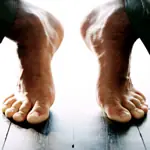
In part two of this blog we continue by first covering the lateral and medial retinaculum and what structures pass underneath them.
Outside (Lateral) Ankle Retinaculum
- This band of fascia holds the tendons of two muscles the peroneous longus and brevis in place just behind the outer ankle bone (fibular malleolus).
- This band also holds the tendons of the peroneous longus and brevis muscles in place. This retinaculum is continuous with the inferior extensor retinaculum.
Pain/Symptom pattern: Tension or a restriction in this area will often cause lateral ankle pain, altering both foot and ankle motion. This can easily lead to ongoing injury and a decrease in athletic performance.
Note: Peroneal retinacula are often injured during ankle sprains (inversion injury). Anytime there is persistent pain after an ankle sprain, a retinaculum injury should be considered. For more information on ankle sprains read my six part blog on Ankle Sprains (Inversion Sprain).
Inside (Medial) Ankle Retinaculum
- This band holds the tendons of the following muscles in place: tibialis posterior, flexor digitorum longus, flexor hallicus longus, and the tibial nerve.
Pain/Symptom pattern:
- Restrictions of the flexor retinaculum are associated with what is known as Tarsal Tunnel Syndrome. In this syndrome people experience sensation of: Pain, tingling and altered sensation anywhere from the ankle, heel, bottom of the feet, to the toes.
- A person with this syndrome will often experience an electric shock sensation, which travels into the foot, when they tap directly over the retinaculum. This is also known as Tinel’s sign.
Tarsal Tunnel Syndrome (TTS): Tarsal Tunnel Syndrome refers to compression of the posterior tibial nerve in the flexor retinaculum.
- Persons with flat feet (fallen arches) are susceptible to TTS. Also any type of enlargement in the Tarsal Tunnel can cause this syndrome which includes swollen tendon, cysts, arthritic bone spur, varicose veins, or even inflammation in the surrounding area.
- If this syndrome is left to progress it can lead to permanent nerve damage.
- Conventional therapy can often be very effective in treating this syndrome (Rest, Ice, and Exercise). Active Release Techniques has developed some specific protocols the release the posterior tibial nerve in the Tarsal Tunnel.
In part three of Ankle Stability – The Retinaculum, we will injury and treatment.
If you would like more information or to purchase our books please go to www.releaseyourbody.com .
If you would like information about our clinic in Calgary Alberta please go to www.kinetichealth.ca.
At Melbourne Podiatrist, our experienced podiatrists come-out with the most effective treatment solutions for shin pain, knee pain, ankle pain and heel pain.
ReplyDelete